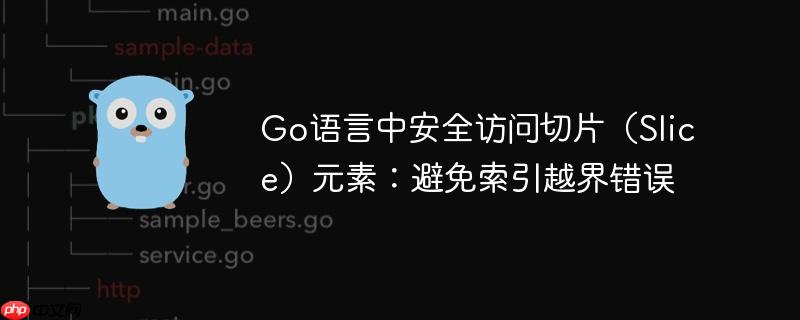
go语言中的切片(slice)是对底层数组的一个连续段的引用,它包含长度(length)和容量(capacity)信息。当尝试通过索引访问切片元素时,go运行时会执行严格的边界检查。如果访问的索引 i 不满足 0 <= i < len(slice) 这个条件,程序就会立即抛出“index out of range”的运行时错误(panic),并终止执行。
这种机制是Go语言内存安全设计的一部分,旨在防止程序访问未分配或不属于其的数据,从而避免更复杂和难以调试的内存损坏问题。与一些脚本语言(如PHP)中访问不存在的数组键可能返回 null 或 undefined 不同,Go语言在设计上更倾向于显式错误,要求开发者主动处理这种边界情况。
为了避免“index out of range”错误,核心原则是在访问切片元素之前,始终验证索引的有效性。以下是几种常用的安全访问切片元素的方法:
这是最直接和推荐的方法。在尝试访问切片中的特定索引之前,通过 len() 函数获取切片的当前长度,并与目标索引进行比较。
示例代码:基本长度检查与复杂场景
立即学习“go语言免费学习笔记(深入)”;
package main
import (
"fmt"
"strings" // 导入 strings 包用于 Split 函数
)
func main() {
// 示例1:基本长度检查
mySlice := []string{"apple", "banana", "cherry"}
// 安全访问索引 0
if len(mySlice) > 0 {
fmt.Println("Element at index 0:", mySlice[0])
} else {
fmt.Println("Slice is empty, cannot access index 0.")
}
// 安全访问索引 1
if len(mySlice) > 1 {
fmt.Println("Element at index 1:", mySlice[1])
} else {
fmt.Println("Slice does not have element at index 1.")
}
// 尝试访问不存在的索引 3
if len(mySlice) > 3 { // 条件为 false,不会发生越界
fmt.Println("Element at index 3:", mySlice[3])
} else {
fmt.Println("Slice does not have element at index 3.")
}
fmt.Println("------------------------------------")
// 示例2:原始问题中的复杂场景
// 假设 url 是一个包含多个字符串元素的切片
urlParts := []string{"http://example.com", "param=value", "another=data"}
// 检查 urlParts 长度是否足够访问索引 1
if len(urlParts) > 1 {
// 尝试对 urlParts[1] 进行字符串分割
// 注意:strings.Split 的第三个参数 n 为 0 时,表示不限制分割次数
tmp := strings.Split(urlParts[1], "=", 0)
// 检查分割后的 tmp 切片长度是否足够访问索引 1
if len(tmp) > 1 {
sess := tmp[1]
fmt.Println("Session value:", sess)
} else {
fmt.Println("Second part of URL does not contain '=' or has no value part.")
}
} else {
fmt.Println("URL parts slice does not have enough elements to check the second part.")
}
// 示例3:一个可能导致越界但通过检查避免的例子
emptySlice := []int{}
if len(emptySlice) > 0 {
fmt.Println("First element of emptySlice:", emptySlice[0])
} else {
fmt.Println("emptySlice is empty.") // 正确处理空切片
}
}当需要遍历切片中的所有元素时,Go语言的 for...range 循环是最佳选择。它会自动处理切片的边界,不会产生索引越界错误。对于空切片,for...range 循环体根本不会执行。
示例代码:使用 range 循环
package main
import "fmt"
func main() {
numbers := []int{10, 20, 30}
fmt.Println("Iterating over 'numbers' slice:")
for index, value := range numbers {
fmt.Printf("Index: %d, Value: %d\n", index, value)
}
emptySlice := []int{}
fmt.Println("\nIterating over 'emptySlice':")
for index, value := range emptySlice {
// 对于空切片,此循环体不会执行,因此是安全的
fmt.Printf("Index: %d, Value: %d\n", index, value)
}
fmt.Println("Finished iterating over 'emptySlice'. (No output means it was empty)")
}如果您的“键”不是连续的整数索引,而是任意的字符串或其他类型,并且您需要检查某个“键”是否存在以及获取其对应的值,那么Go语言的 map 类型是更合适的选择。map 提供了安全的查找机制,通过多返回值来指示键是否存在。
示例代码:使用 map 安全查找
package main
import "fmt"
func main() {
config := map[string]string{
"port": "8080",
"host": "localhost",
}
// 安全查找键 "port"
if value, ok := config["port"]; ok {
fmt.Println("Port:", value)
} else {
fmt.Println("Port not found in config.")
}
// 尝试查找不存在的键 "timeout"
if value, ok := config["timeout"]; ok {
fmt.Println("Timeout:", value)
} else {
fmt.Println("Timeout not found in config.") // ok 为 false
}
}value, ok := myMap[key] 这种语法是Go语言中检查 map 键是否存在的惯用方式。ok 布尔变量会告诉我们键是否存在。
Go语言的“index out of range”错误是其内存安全特性的一部分,强制开发者在访问切片元素时进行显式的边界检查。解决这一问题的核心在于使用 len() 函数进行长度判断,确保访问的索引始终在有效范围内。对于遍历操作,for...range 循环提供了天然的安全性。理解并遵循这些实践,能够帮助Go开发者编写出更加健壮、可靠且不易崩溃的应用程序。
以上就是Go语言中安全访问切片(Slice)元素:避免索引越界错误的详细内容,更多请关注php中文网其它相关文章!

每个人都需要一台速度更快、更稳定的 PC。随着时间的推移,垃圾文件、旧注册表数据和不必要的后台进程会占用资源并降低性能。幸运的是,许多工具可以让 Windows 保持平稳运行。

Copyright 2014-2025 https://www.php.cn/ All Rights Reserved | php.cn | 湘ICP备2023035733号